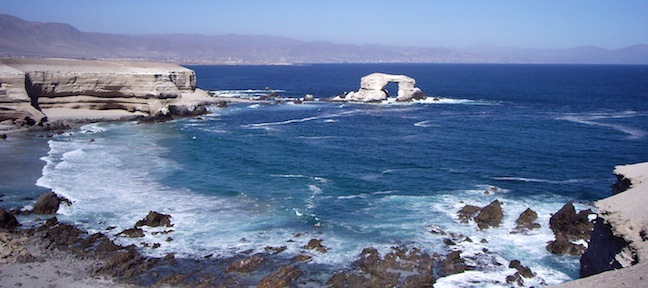
Nature along the Rock-bound Shore
Antofagasta, Chile; 2011.
![]()
Question | Flavors of the sea | Seaside meadows | zones of life | terms | tide pools | pollution | source
![]()
"When tide is rising the shore is a place of unrest, with the surge leaping high over jutting rocks . . . ."
p. 39.
The restless sea envelopes this Elephant seal reserve at Ano Nuevo State Park, central California coast.
What are the significant features of these habitats into which the rocky shore is divided?
Rocky shores, The Edge of the Sea, pp. 39-124.
Rachel Carson, marine biologist who worked for the U.S. Fish and Wildlife Service (USF&WS)
This was her third major book, published in 1955.
"All the life of the shore –the past and the present– by the very fact of its existence there, gives evidence that it has dealt successfully with the realities of the world – the towering physical realities of the sea itself, and the subtle life relationships that bind each living thing to its own community. The patterns of life as created and shaped by these realities intermingle and overlap so that the major design is exceedingly complex."
p. 11
"...determines the visible patterns of life."
p. 12
What are the enduring patterns of seashore life as depicted on the rocky coast?
Childe Hassam, the rockbound shore, (circa 1888)
Along the rocky shore, the bands of life due are apparent due to the seas waves, tides, and currents. Here these zones are easiest to see, but hidden here, too, are secrets of adaptive and reproductive strategies common to all life.
Tides are confusing because of the character of any Seashoreline.
"under these waters of the seas edge. . . .nothing is visible."
When the tide is rising, the shore is a place of unrest either the surge leaping high over jutting rocks and running in lacy cascades of foam over the landward side of massive boulders."
How high are the hightides depends on 1) the shape of the basin, 2) volume of water, 3) diurnal variations in tidal range (amplitude) and intervals (frequency), and 4) the time of the lunar calendar. See
On the ebb tide,
"Small dingy snails move about over the rocks that are slippery with the growth of infinitesimal green plants."
The sea gulls, "...and give them entrance to the strip between the tide lines."
p. 39.
Flavors of the sea | Seaside meadows | zones of life | terms | tide pools | pollution | source | end
"Meadows of brown rockweeds appear on the gently sloping rocks of the shore as the tide imperceptibly ebbs."

p. 40
The pools are gardens of color composed of delicate green and ochre-yellow of encrusting sponge, the pale pink of hydroids that stand like clusters of fragile spring flowers, the bronze and electric blue gleams of the Irish moss, the old-rose beauty of the coralline algae."
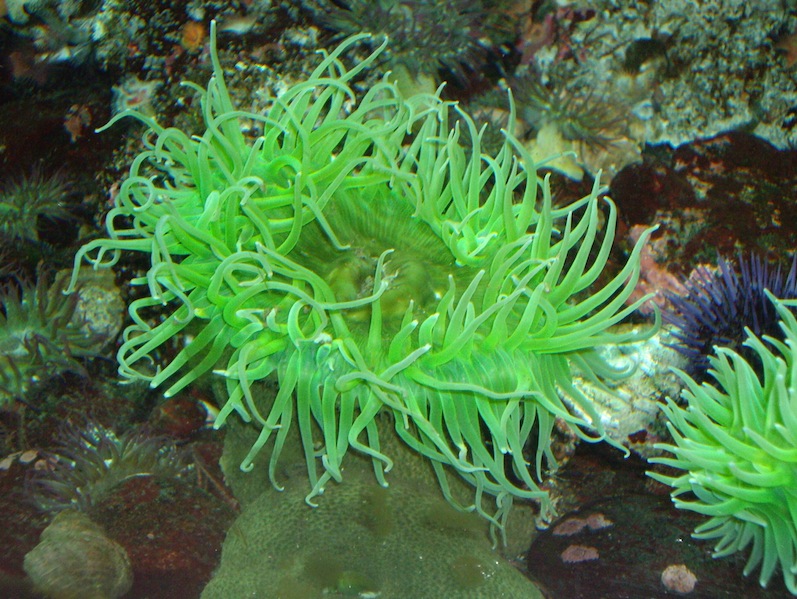
"and the salt smell of the rime that glitters on the sun-dried rocks."
p. 41.
All the trees, the living and the dead, are clothed with green and silver crusts of lichens. Tufts of the bearded lichen or old man's beard hang from the branches like bits of sea mist tangled there."
Where the mountainous ridges and the valleys lay at an angle to the coast, the sea ran far up between the hills and occupied the valleys. This was the origin of the deeply indented and exceedingly irregular coast that is characteristic of much of Maine."
p. 42-43.
"the weak rock lowlands formed in the Carboniferous period."
p. 44.
succession of life on the shore
"Only after the establishment of the plankton-strainers (barnacles and mussels) and the grazers (snails) could the carnivores settle and survive."
 p. 45
p. 45
Intertidal and upper littoral zones

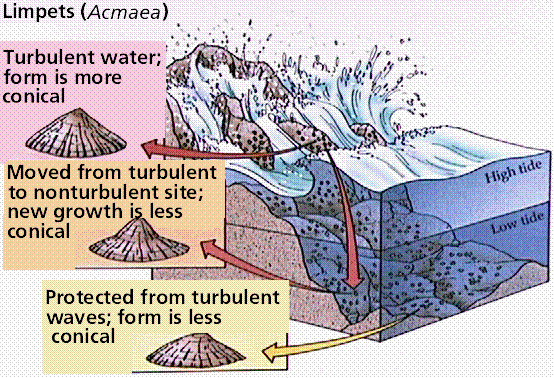 eaters and eaten -- "living out their lives in the horizontal zones created by the tides."
eaters and eaten -- "living out their lives in the horizontal zones created by the tides."
Ibid.
Intertidal, lower littoral and sub littoral zones

Predation patterns along the shore, the star fish, Pisaster.
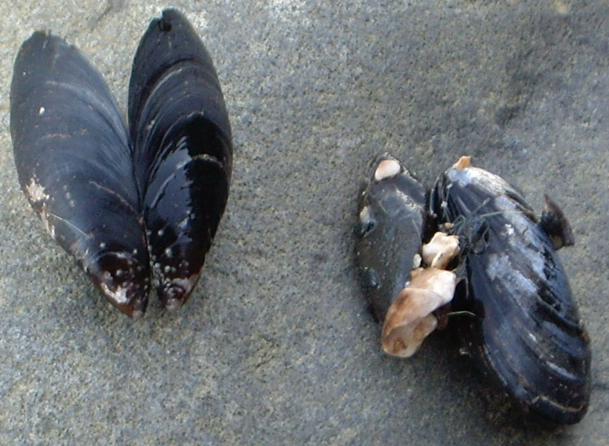
Flavors of the sea | Seaside meadows | zones of life | terms | tide pools | pollution | source | end
The littoral may be subdivided by natural features based on the elemental effects of the tides into adjacent, sequential zones from uppermost to lowest they are:
p. 70.
"This is the sign of the meeting of land and sea."
p.47.
| water levels | bands of life | 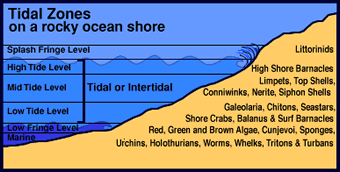 |
|---|---|---|
| The surf or splash area | The black zone | |
| Highest tide | Periwinkle zone | |
| mean high tide | Barnacle zone | |
| mean low tide | Rockweed zone | |
| Lowest tide | Irish moss zone | |
| below the usual tidal flux | Laminarian zone | |
| Near shore benthic zone | ||
pp. 46-80.
The blue-greens or cyanobacteria are among the oldest and most versatile form of life on earth, they take nitrogen out of the air and fix it into living tissues for other creatures to consume creating a stable food-chain.
Rock shores
The snails are grazers that feed on algae.
"However the barnacle became what it is, its larval stages clearly proclaim its crustacean ancestry, although early zoologists ...labeled it a mollusc."
p. 53.
"No one knows how many of the baby barnacles (larvae) riding shoreward on the waves make a safe landing, how many fail in the quest for a clean hard substratum."
p. 53-54.
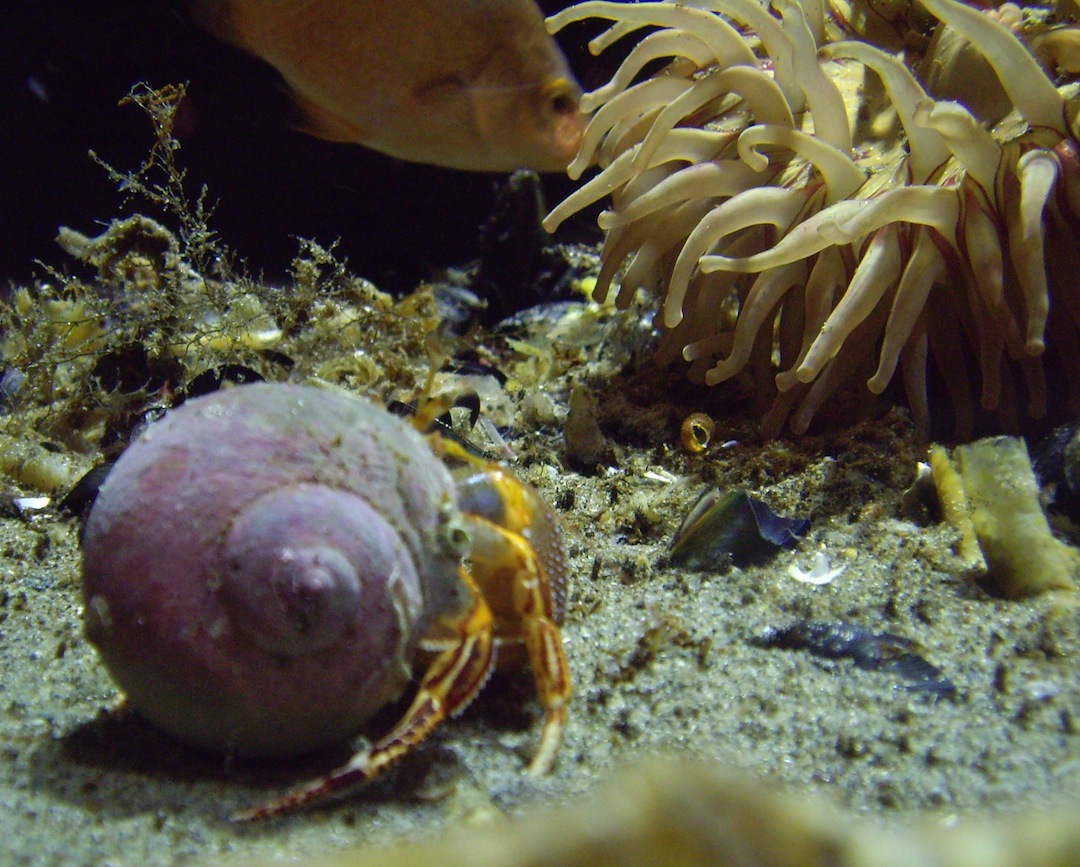

Hermit crab and anemones feeding as the flood tide is in submerging the Rockweed zone.
|
|
|
Rachel
Carson in the Maine Woods. |
Flavors of the sea | Seaside meadows | zones of life | terms | tide pools | pollution | source
Patterns of disturbing change.
The coast is both a crowded place for sea life and a dumping ground for civilization where our achievements converge with our rejected garbage that seems to not properly disappear from view.
Coastal pollution is a serious situation due to suburban, agricultural, and industrial runoff, in confined areas along the shore.
In addition to these elements, life also must adjust to pollution:
Flavors of the sea | Seaside meadows | zones of life | terms | tide pools | pollution | source | end
Antarctic continent; The northernmost section of the Larsen Ice Shelf Complex, called Larsen A, lost about 1,500 square kilometers of ice in an abrupt event in January 1995, shown after & before, below. See here for the Larsen B Ice sheet collapse in 2002.
"...the burden of a vast glacier."
p. 42.
"Offshore, chains of islands jut out obliquely into the sea, one beyond another – half submerged ridges of the former land mass."
p. 43.
As the geologic events are reckoned, all this happened rather rapidly, and suddenly."
Ibid.
Flavors of the sea | Seaside meadows | zones of life | terms | tide pools | pollution | source | end
She marvels at tube worms and their eggs, the tiny larvae and says:
"There is also a response,...to cosmic forces. Every fortnight, on the moon's quarter, a batch of eggs is fertilized and taken into the brood chamber to begin its development, And at the same time the larvae that have been made ready during the previous fortnight are expelled into the sea. By this timing--the release of the young always occurs on the neap tide, when neither the rise nor the fall of the water is of great extent, and even for so small a creature the chances of remaining within the rockweed zone are good."
p. 83.
"Looking down into the small world confined within the walls of the cave, one feels the rhythms of the greater sea world beyond. The waters of the pool are never still. Their level changes not only gradually with the rise and fall of the tide, but also abruptly with the pulse of the surf. As the backwash of a wave draws it seaward, the water falls away rapidly, then with a sudden reversal the in rushing water foams and surges upward almost to one's face."
p. 118.
Rachel Louise Carson, The Edge of the Sea. Boston: Houghton Mifflin, 1955.

The
Marginal World
Patterns
of Shore Life
The Rocky
Shores
The Rim
of Sand
The Coral
Coast
The Enduring
Sea
![]()
Question | Flavors of the sea | Seaside meadows | zones of life | terms | tide pools | pollution | source
![]()